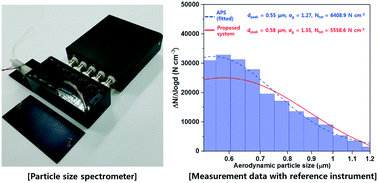Particle size spectrometer using inertial classification and electrical measurement techniques for real-time monitoring of particle size distribution†
Abstract
To achieve real-time monitoring of aerodynamic submicron particle size distributions at a point-of-interest, we developed a high-performance particle size spectrometer that is compact, low-cost, and portable. The present system consists of four key components: a unipolar mini-discharger for electrically charging particles, an inertial size-separator for classifying charged particles into five size fractions in terms of their aerodynamic sizes, a portable multi-channel electrometer for detecting femto-ampere currents carried by charged particles at each stage, and a retrieval algorithm for converting the current data into a smooth particle size distribution. The unipolar mini-discharger and inertial size separator were quantitatively characterised by using standard polystyrene latex (PSL) particles. The experimentally determined cut-off diameters at each stage in the inertial size separator were 1.17, 0.94, 0.71, 0.54, and 0.23 μm, respectively. Then, the system was compared with a commercial reference aerodynamic particle sizer (APS) in the environment where the number concentration and the average size of TiO2 particles were changing. The present system resolved peak size and geometric standard deviation of particles to within 11.2%, and 6.3%, respectively, indicating that the system can be used to accurately monitor submicron particle size distributions in real time.



 Please wait while we load your content...
Please wait while we load your content...